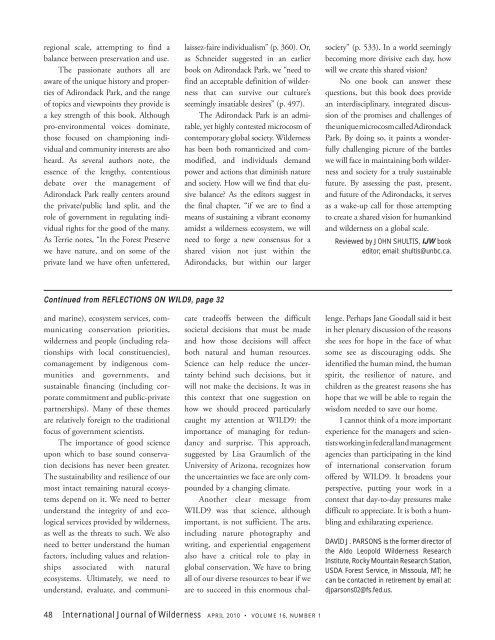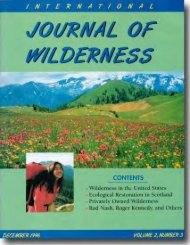Ten Tribes Reclaiming, Stewarding, and Restoring Ancestral Lands
Ten Tribes Reclaiming, Stewarding, and Restoring Ancestral Lands
Ten Tribes Reclaiming, Stewarding, and Restoring Ancestral Lands
You also want an ePaper? Increase the reach of your titles
YUMPU automatically turns print PDFs into web optimized ePapers that Google loves.
egional scale, attempting to find a<br />
balance between preservation <strong>and</strong> use.<br />
The passionate authors all are<br />
aware of the unique history <strong>and</strong> properties<br />
of Adirondack Park, <strong>and</strong> the range<br />
of topics <strong>and</strong> viewpoints they provide is<br />
a key strength of this book. Although<br />
pro-environmental voices dominate,<br />
those focused on championing individual<br />
<strong>and</strong> community interests are also<br />
heard. As several authors note, the<br />
essence of the lengthy, contentious<br />
debate over the management of<br />
Adirondack Park really centers around<br />
the private/public l<strong>and</strong> split, <strong>and</strong> the<br />
role of government in regulating individual<br />
rights for the good of the many.<br />
As Terrie notes, “In the Forest Preserve<br />
we have nature, <strong>and</strong> on some of the<br />
private l<strong>and</strong> we have often unfettered,<br />
Continued from REFLECTIONS ON WILD9, page 32<br />
<strong>and</strong> marine), ecosystem services, communicating<br />
conservation priorities,<br />
wilderness <strong>and</strong> people (including relationships<br />
with local constituencies),<br />
comanagement by indigenous communities<br />
<strong>and</strong> governments, <strong>and</strong><br />
sustainable financing (including corporate<br />
commitment <strong>and</strong> public-private<br />
partnerships). Many of these themes<br />
are relatively foreign to the traditional<br />
focus of government scientists.<br />
The importance of good science<br />
upon which to base sound conservation<br />
decisions has never been greater.<br />
The sustainability <strong>and</strong> resilience of our<br />
most intact remaining natural ecosystems<br />
depend on it. We need to better<br />
underst<strong>and</strong> the integrity of <strong>and</strong> ecological<br />
services provided by wilderness,<br />
as well as the threats to such. We also<br />
need to better underst<strong>and</strong> the human<br />
factors, including values <strong>and</strong> relationships<br />
associated with natural<br />
ecosystems. Ultimately, we need to<br />
underst<strong>and</strong>, evaluate, <strong>and</strong> communi-<br />
laissez-faire individualism” (p. 360). Or,<br />
as Schneider suggested in an earlier<br />
book on Adirondack Park, we “need to<br />
find an acceptable definition of wilderness<br />
that can survive our culture’s<br />
seemingly insatiable desires” (p. 497).<br />
The Adirondack Park is an admirable,<br />
yet highly contested microcosm of<br />
contemporary global society. Wilderness<br />
has been both romanticized <strong>and</strong> commodified,<br />
<strong>and</strong> individuals dem<strong>and</strong><br />
power <strong>and</strong> actions that diminish nature<br />
<strong>and</strong> society. How will we find that elusive<br />
balance? As the editors suggest in<br />
the final chapter, “if we are to find a<br />
means of sustaining a vibrant economy<br />
amidst a wilderness ecosystem, we will<br />
need to forge a new consensus for a<br />
shared vision not just within the<br />
Adirondacks, but within our larger<br />
cate tradeoffs between the difficult<br />
societal decisions that must be made<br />
<strong>and</strong> how those decisions will affect<br />
both natural <strong>and</strong> human resources.<br />
Science can help reduce the uncertainty<br />
behind such decisions, but it<br />
will not make the decisions. It was in<br />
this context that one suggestion on<br />
how we should proceed particularly<br />
caught my attention at WILD9: the<br />
importance of managing for redundancy<br />
<strong>and</strong> surprise. This approach,<br />
suggested by Lisa Graumlich of the<br />
University of Arizona, recognizes how<br />
the uncertainties we face are only compounded<br />
by a changing climate.<br />
Another clear message from<br />
WILD9 was that science, although<br />
important, is not sufficient. The arts,<br />
including nature photography <strong>and</strong><br />
writing, <strong>and</strong> experiential engagement<br />
also have a critical role to play in<br />
global conservation. We have to bring<br />
all of our diverse resources to bear if we<br />
are to succeed in this enormous chal-<br />
48 International Journal of Wilderness APRIL 2010 VOLUME 16, NUMBER 1<br />
society” (p. 533). In a world seemingly<br />
becoming more divisive each day, how<br />
will we create this shared vision?<br />
No one book can answer these<br />
questions, but this book does provide<br />
an interdisciplinary, integrated discussion<br />
of the promises <strong>and</strong> challenges of<br />
the unique microcosm called Adirondack<br />
Park. By doing so, it paints a wonderfully<br />
challenging picture of the battles<br />
we will face in maintaining both wilderness<br />
<strong>and</strong> society for a truly sustainable<br />
future. By assessing the past, present,<br />
<strong>and</strong> future of the Adirondacks, it serves<br />
as a wake-up call for those attempting<br />
to create a shared vision for humankind<br />
<strong>and</strong> wilderness on a global scale.<br />
Reviewed by JOHN SHULTIS, IJW book<br />
editor; email: shultis@unbc.ca.<br />
lenge. Perhaps Jane Goodall said it best<br />
in her plenary discussion of the reasons<br />
she sees for hope in the face of what<br />
some see as discouraging odds. She<br />
identified the human mind, the human<br />
spirit, the resilience of nature, <strong>and</strong><br />
children as the greatest reasons she has<br />
hope that we will be able to regain the<br />
wisdom needed to save our home.<br />
I cannot think of a more important<br />
experience for the managers <strong>and</strong> scientists<br />
working in federal l<strong>and</strong> management<br />
agencies than participating in the kind<br />
of international conservation forum<br />
offered by WILD9. It broadens your<br />
perspective, putting your work in a<br />
context that day-to-day pressures make<br />
difficult to appreciate. It is both a humbling<br />
<strong>and</strong> exhilarating experience.<br />
DAVID J. PARSONS is the former director of<br />
the Aldo Leopold Wilderness Research<br />
Institute, Rocky Mountain Research Station,<br />
USDA Forest Service, in Missoula, MT; he<br />
can be contacted in retirement by email at:<br />
djparsons02@fs.fed.us.










